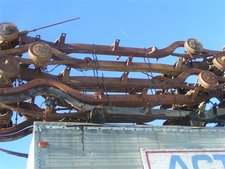Body-on-frame

Body-on-frame is an automobile construction technology. Mounting a separate body to a rigid frame which supports the drivetrain was the original method of building automobiles, and its use continues to this day. The original frames were made of wood (commonly ash), but steel ladder frames became common in the 1930s.
In the USA the frequent changes in automobile design made it necessary to use a ladder frame rather than monocoque to make it possible to change the design without having to change the chassis, allowing frequent changes and improvements to the car's bodywork and interior (where they were most noticeable to customers) while leaving the chassis and driveline unchanged, and thus keeping cost down and design time short. It was also easy to use the same chassis and driveline for several very different cars. Especially in the days before computer-aided design, this was a big advantage. [1]
Most small passenger vehicles switched to Body Frame Integral construction in the 1960s, leaving just trucks, buses and large cars using conventional frames. The switch continued for several decades - even small SUVs typically use unibody construction today. Body-on-frame remains the preferred construction method for heavy-duty commercial vehicles, especially those which are intended to carry and pull heavy loads, such as trucks.
The Lincoln Town Car dominates the American limousine market because it is the last American luxury car made with body-on-frame, which makes it easy to "stretch."
Advantages and disadvantages compared to unibody
Advantages
- Easier to design, build and modify (less of an issue now that CAD is commonplace), but still an advantage for coachbuilt vehicles.
- More suited for heavy duty usage and can be more durable.
- Easier to repair after accidents.
- Overall better ride quality [2] for SUVs.
Disadvantages
- Heavier than unibody - lower performance and/or higher fuel consumption.
- Center of gravity is usually higher - compromising stability and handling.
- Less resistant to torsion (flexing of the whole car in corners) - compromising handling and roadholding.
- No crumple zone - higher rate of death and serious injury.
- Higher production costs.
See also
External Links & Sources
- Article about body-on-frame in modern cars and trucks
- Body on frame and unibody in SUVs
- Ford assembly line featuring body-on-frame car (historic)
